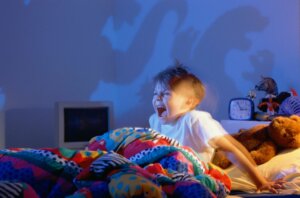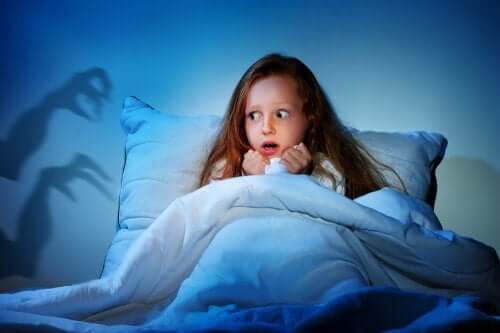Sleep Paralysis in Children and Adolescents


Written and verified by the psychologist Elena Sanz Martín
Sleep paralysis in children and adolescents is a common condition. In fact, it can affect 50% of the population at some point and approximately 4% on a recurring basis. However, that doesn’t mean it’s not disconcerting and terrifying, especially for children.
Although adults may experience true anguish when they experience this disorder, the impact for children and adolescents can be even greater. In this article, we’ll tell you everything you need to know about it to understand and help your child if they suffer from paralysis.
What is sleep paralysis in children and adolescents?
This sleep disorder occurs at the time of transition between sleep and wakefulness. That’s why it usually happens when we’re waking up or when we’re falling asleep. When it happens, we’re totally incapable of moving, since all voluntary muscles are paralyzed except for the eyes and the respiratory diaphragm.
In addition, the larynx is paralyzed, so the person can’t make any sound either. However, despite that, they’re still cognitively awake. Obviously, this causes an enormous amount of fear in the person suffering, since they’re conscious but trapped in their immobile body.

In addition, this condition is usually accompanied by visual, auditory or tactile hallucination that is terrifying and frightening. Because of that, the person may see figures, hear sounds or feel like someone or something is pressing on their chest.
Remember, the respiratory diaphragm isn’t paralyzed during sleep paralysis, but that feeling happens because the person’s breathing isn’t deep or complete.
The episodes are usually short, and they can range from 20 seconds to two minutes. In addition, it goes away quickly without leaving sequelae. Also, you should keep in mind that it’s not a dangerous condition. However, it’s very distressing and causes a lot of fear and vulnerability.
Where does sleep paralysis in children and adolescents come from?
Despite the various paranormal explanations people have for sleep paralysis, it has a clearly psychological basis. First of all, we have to remember that hypotonia occurs naturally in our muscles while we sleep. With sleep paralysis, however, there’s a dysfunction in this mechanism. This can last a few moments after the person has woken up.
In addition, hallucinations are often products of REM sleep that mistakenly break into consciousness. Ultimately, there’s a mismatch between body and mind, so the latter wakes up earlier while the body stays “asleep.”
Like we mentioned, half the population will experience an episode of sleep paralysis at some point in their life without experiencing major repercussions. In addition, another percentage will suffer from it on a recurring basis.
Sleep paralysis is a disorder in itself and isn’t necessarily caused by other diseases. Also, researchers have found a family propensity to these types of episodes in some cases. However, it can also be a symptom of narcolepsy. In these cases, it’s necessary to see a specialist so they can diagnose the issue.

How to prevent and deal with these episodes
Often, the first episodes of sleep paralysis occur before the age of 19. If your child experiences this condition, there’s a few recommendations you can follow:
- Keep a regular sleep schedule. Make sure your child is getting plenty of rest because irregular sleep routines and sleep deprivation can cause this condition.
- Avoid states of stress. Anxiety and worry can cause sleep paralysis, so help your child stay calm through relaxation and meditation techniques.
- Try to make sure your child doesn’t sleep on their back. This position is associated with a greater likelihood of sleep paralysis.
However, if an episode occurs, despite all these recommendations, the most important thing is to try to stay calm. Remember, your child is safe. Knowing why sleep paralysis in children and adolescents happens can lower your panic level.
You have to keep in mind that the episode will end in a few moments. In addition, you can try having your child move a small part of their body (like their fingers), to help regain mobility. If the episodes are frequent, don’t hesitate to talk to a specialist.
Sleep paralysis in children and adolescents is a common condition. In fact, it can affect 50% of the population at some point and approximately 4% on a recurring basis. However, that doesn’t mean it’s not disconcerting and terrifying, especially for children.
Although adults may experience true anguish when they experience this disorder, the impact for children and adolescents can be even greater. In this article, we’ll tell you everything you need to know about it to understand and help your child if they suffer from paralysis.
What is sleep paralysis in children and adolescents?
This sleep disorder occurs at the time of transition between sleep and wakefulness. That’s why it usually happens when we’re waking up or when we’re falling asleep. When it happens, we’re totally incapable of moving, since all voluntary muscles are paralyzed except for the eyes and the respiratory diaphragm.
In addition, the larynx is paralyzed, so the person can’t make any sound either. However, despite that, they’re still cognitively awake. Obviously, this causes an enormous amount of fear in the person suffering, since they’re conscious but trapped in their immobile body.

In addition, this condition is usually accompanied by visual, auditory or tactile hallucination that is terrifying and frightening. Because of that, the person may see figures, hear sounds or feel like someone or something is pressing on their chest.
Remember, the respiratory diaphragm isn’t paralyzed during sleep paralysis, but that feeling happens because the person’s breathing isn’t deep or complete.
The episodes are usually short, and they can range from 20 seconds to two minutes. In addition, it goes away quickly without leaving sequelae. Also, you should keep in mind that it’s not a dangerous condition. However, it’s very distressing and causes a lot of fear and vulnerability.
Where does sleep paralysis in children and adolescents come from?
Despite the various paranormal explanations people have for sleep paralysis, it has a clearly psychological basis. First of all, we have to remember that hypotonia occurs naturally in our muscles while we sleep. With sleep paralysis, however, there’s a dysfunction in this mechanism. This can last a few moments after the person has woken up.
In addition, hallucinations are often products of REM sleep that mistakenly break into consciousness. Ultimately, there’s a mismatch between body and mind, so the latter wakes up earlier while the body stays “asleep.”
Like we mentioned, half the population will experience an episode of sleep paralysis at some point in their life without experiencing major repercussions. In addition, another percentage will suffer from it on a recurring basis.
Sleep paralysis is a disorder in itself and isn’t necessarily caused by other diseases. Also, researchers have found a family propensity to these types of episodes in some cases. However, it can also be a symptom of narcolepsy. In these cases, it’s necessary to see a specialist so they can diagnose the issue.

How to prevent and deal with these episodes
Often, the first episodes of sleep paralysis occur before the age of 19. If your child experiences this condition, there’s a few recommendations you can follow:
- Keep a regular sleep schedule. Make sure your child is getting plenty of rest because irregular sleep routines and sleep deprivation can cause this condition.
- Avoid states of stress. Anxiety and worry can cause sleep paralysis, so help your child stay calm through relaxation and meditation techniques.
- Try to make sure your child doesn’t sleep on their back. This position is associated with a greater likelihood of sleep paralysis.
However, if an episode occurs, despite all these recommendations, the most important thing is to try to stay calm. Remember, your child is safe. Knowing why sleep paralysis in children and adolescents happens can lower your panic level.
You have to keep in mind that the episode will end in a few moments. In addition, you can try having your child move a small part of their body (like their fingers), to help regain mobility. If the episodes are frequent, don’t hesitate to talk to a specialist.
All cited sources were thoroughly reviewed by our team to ensure their quality, reliability, currency, and validity. The bibliography of this article was considered reliable and of academic or scientific accuracy.
- Núñez, J. E. C. (2011). Parálisis del Sueño. Synapsis, 3(2), 14-18.
- Roballo Ros, F. (2016). Parálisis del sueño: desenmascarando el fantasma, exploración holística y psicológica.
This text is provided for informational purposes only and does not replace consultation with a professional. If in doubt, consult your specialist.








